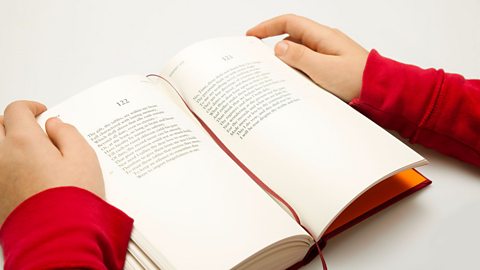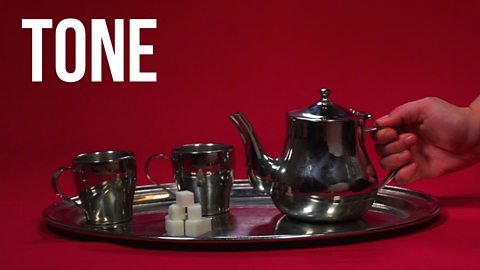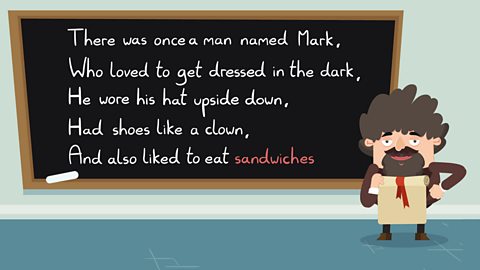Did you know?
William Shakespeare is the bestselling poet of all time.
The word 'poetry' is from the Greek term poiesis, which means 'making'.
The oldest written poem is the Epic of Gilgamesh originating from Babylon.
Poetry might seem intimidating to study at first, but it’s like any other kind of writing that we analyse – it uses language and other techniques to create an effect for the reader and convey what the writer is trying to say. Don’t worry about not ‘getting’ it, especially at first – just work with what you can find and often you’ll get an understanding of what the poet is doing.
You probably already know that poems don’t have to rhyme or follow a certain pattern or rhythm to be classed as a poem. They can also be about anything, from a small feeling to a huge war. There are lots of examples of poems where people disagree about what it means or what it is about – even the poet! – so don’t get too worried about making sure you have the “right” idea about a poem you study.
If you don’t feel confident, start small: you can look for clues in the language or shape of the poem and work from there. Sometimes even just the title can give you a sense of what the poet is trying to say, so keep an open mind.
Approaching a poem
Here are some good ideas for approaching any poem you study:
- Read it out loud to get a sense of what the rhythm is and where the rhymes are, if there are any.
- Read it again and see if you can tell what kind of person is speaking.
- Is the person angry? Confused? In love? Descriptive? Is there anything in the poem that tells you what they feel about the things they’re talking about?
- Look at the language. Underline any words that seem important. What do those individual words make you think of?
- If you feel a bit stuck or can’t see any language that looks significant, try looking for words that are positive and words that are negative. Underline or ring them in different colours and then look at where they are. Are there more positive or negative words? Are they mixed throughout the text or does one change into the other?
- Look at the title. What does it make you think of? What could it be adding to the poem?
- Half-close your eyes and look at the shape of the poem. Is it even? Uneven? Long? Short? Thick? Thin? Square? Scattered? Does it look like anything in particular?
- Look at the punctuation. Is there any? Are there questions? Exclamations? Lots of pauses or dashes or interruptions?
- Is the poem in one section or broken up? Where do the breaks happen? What might they be showing?
- Are there any words or parts of the poem that confuse you? Mark them out so you can see them clearly. Do the bits that confuse you match up in any way?
Once you’ve made these initial observations you should have at least one or two ideas about what is happening in the poem. These ideas are important because you came up with them yourself based on what the poem was telling you, so make a quick note of them before you try to find out what other people thought of the piece!
Poetic devices
Many of the literary techniques or devices used in poetry are ones you will recognise from other types of writing, and they will have a similar effect on the reader as they would if they were being used in a short story, advert or letter.
- Similes – a comparison using “like” or “as”
- Metaphors – a direct comparison. Some poems use an extended metaphor, meaning they build on the idea of the initial comparison with lots more detail. In ‘The Sea’, the poet James Reeves opens with the line “The sea is a hungry dog” and goes on to list ways in which the sea behaves in a doglike manner, building the rest of the poem around this comparison. In a poem like this, the extended metaphor may also be called a conceit.
- Onomatopoeia – words based on the sound they are describing, such as “bang”, “buzz” or “hiss”. Onomatopoeic words are common in poems because sound is such an important element of poetry.
- Repetition – repetition of a word or phrase, maybe even a whole stanza. This tends to give a rhythmic effect, like a chorus in a song. ‘The Charge of the Light Brigade’ by Alfred, Lord Tennyson is about soldiers riding into a doomed battle; it uses repetition of several phrases to create a strong rhythm like hooves galloping, and repeats ‘the six hundred’ at the end of each stanza to remind you of the six hundred men who fought.
Half a league, half a league,
Half a league onward,
All in the valley of Death
Rode the six hundred.
"Forward, the Light Brigade!
Charge for the guns!" he said:
Into the valley of Death
Rode the six hundred.
- Imagery – use of figurative language to create an image in the reader’s mind. Sometimes imagery in the poem helps to create symbolism, where one thing represents another. Simon Armitage’s poem ‘November’ is about an old lady being put into a nursing home; the month of November used in the title becomes a symbol for the fact she is nearing the end of her life, just as November is nearly the end of the year. Poetry can also often use allusions, or references to famous characters, situations or events in other books or films.
Some poetic devices tend to be used more in poetry than any other type of writing, simply because of the way poems are formed and structured. They are usually to do with rhyme and rhythm, because these affect the way the poem sounds. Poems are often intended to be shared aloud, so sound is important and many poetic devices relate to the way the words are spoken.
Here are some of the most common ones:
- Alliteration– you will certainly be familiar with alliteration, which is the term we commonly use for several words in close proximity that begin with the same sound, such as “curling kite-tails kick and flutter”. A similar device often used in poetry is consonance, where the similar sounds are used elsewhere in the word, usually at the end; “bleed”, “blood” and “blade” would be an example of this in the sentence “The blood we bleed onto the blade”. The words don’t rhyme because the vowels used in each are different, but we notice the similar sounds when we hear the poem and it draws our attention to the phrase. Carolyn Wells’ tongue twister ‘The Butter Betty Bought’ uses consonance:
Betty Botter bought a bit of butter;
“But,” she said, “this butter's bitter!
If I put it in my batter
It will make my batter bitter.
But a bit o’ better butter
Will but make my batter better.”
When you notice consonance in a poem, try to comment on what the specific sound that is repeated makes you think of, or how it might relate to the poem. A soft ‘sh’ sound or a repeated murmuring ‘m’ sound could be used to create a calm effect or make us think of the sea, for example.
Rhyme – rhyming sounds are probably the feature most people think of first when talking about poetry, and we’re used to rhyming poems like nursery rhymes so it’s pretty easy for us to spot rhymes in most poetry. Another feature to look for is assonance which is use of a similar vowel sound within a sentence. It isn’t a true rhyme because the syllables start and end differently, but the vowel sound flows through the line and the reader notices the sound.
When you notice assonance in a poem, try to comment on what the specific sound that is repeated makes you think of, or how it might relate to the poem. For example, we make the shape of a smile when we pronounce long ‘e’ sounds so the poet might use some of these in a happy or funny poem. In the poem ‘The Captain of the 1964 Top of the Form Team’, Carol Ann Duffy’s line “My thick kids wince” is short but repeats the short ‘i’ short sound to help emphasise how resistant the children are to their dad’s behaviour.Rhythm – there are lots of specific names for rhythmic elements in poetry, but you don’t need to know many of them for general study. One you may hear being used occasionally is metre, which simply means the number and arrangement of syllables in a line or section of a poem.
Learn how to understand rhythm in poetry
Because of the way we pronounce words, emphasis tends to vary across the syllables or beats of each word, and this can affect how words sound in order because of where the stronger syllable falls. In words like ‘garden’, ‘quiet’ or ‘basketball’, we stress the first syllable more strongly; in words like ‘giraffe’ or ‘suspend’ it is the second syllable. Longer words like ‘banana’ or ‘example’ might have the stressed syllable in the middle, and there are words like ‘afternoon’, ‘suspect’ and ‘project’ where the emphasis can vary.Many poems rely on fitting a certain number of syllables into a line to sound right, and often the emphasised syllables being in the right places are just as important as there being the right number of them.
The first lines of the nursery rhyme ‘Mary had a little lamb’ give us a nice even rhythm because the pattern of the syllables alternates between strong and weak:
Mary had a little lamb,Its fleece was white as snow.
If we use the same words but in a different order, it keeps the same number of beats but the rhythm is disrupted and it doesn’t sound quite right:
A little lamb Mary had, White as snow was its fleece.
Probably the most common metre you will find in poems you study, such as Shakespearean sonnets, is iambic pentameter. It sounds complicated, but one iamb is just a weak-strong, or unstressed-stressed syllable combination (commonly described as being like the da-DUM of a heartbeat), and pentameter means five of them, like a pentagon has five sides – so iambic pentameter is just a line of five strong-weak beats, like this in Sonnet 104:
To me, fair friend, you never can be old,
For as you were when first your eye I eyed,
Such seems your beauty still. Three winters cold
Have from the forests shook three summers’ pride…
There are five sections to the line, and five stresses, following that da-DUM pattern, an unstressed syllable followed by a stressed syllable.
To me fair friend you never can be old,
Iambic pentameter can be roughly summarised as having 10 syllables a line. This is not always true due to the stressed and unstressed syllables but a quick guide is to count the syllables in each line. If each one has 10 or 11 then it is likely to be iambic pentameter.
Iambic pentameter is thought to be the sound of natural conversation and so poets will often use it to create a conversational or natural feel to the poem.
When talking about rhythm or meter in a poem you study, try counting out the beats to the lines and commenting on whether they are mostly the same throughout the poem or if they vary. If they’re similar throughout, the poet may have wanted a regular or rhythmic effect to echo something about what is happening in the poem; if they’re different, try to think why the poet might have wanted to disrupt the rhythm.

Which of these demonstrates a line of iambic pentameter?
a) da-DUM da-DUM da-DUM
b) da-DUM da-DUM da-DUM da-DUM da-DUM
c) DUM-DUM DUM-DUM DUM-DUM DUM-DUM DUM-DUM
Answer:
b) shows iambic pentameter.
Test Yourself
More on Understanding poetry
Find out more by working through a topic
- count2 of 4

- count3 of 4

- count4 of 4
